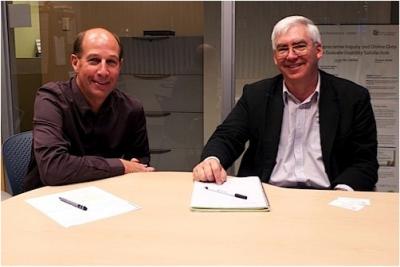BCcampus’s leadership in distance learning and flexible trades training has attracted international attention.
Yesterday, we had a visit at BCcampus from David Scannell, Curriculum Services Manager in the Learning Innovation and Development unit from Holmsglen in Australia. Holmsglen is a TAFE. In Australia, training and further education or TAFE (pronounced /ˈteɪf/) institutions provide a wide range of predominantly vocational tertiary education courses, mostly qualifying courses under theNational Training System/Australian Qualifications Framework / Australian Quality Training Framework. (Source: Wikipedia)

The purpose of David’s visit to Canada is to investigate innovative practices in flexible learning for trades training. He visited BCcampus to find out more about our systemic role with educational technology, and specifically about our role in facilitating the E-PPRENTICE initiative that was funded by the Industry Training Authority of B.C. (ITACBC) in 2009-2010.
Our conversation with David Scannell reminded us that one of the ideas we originally proposed for E-PPRENTICE was a digital library of open resources for flexible trades training. Our thinking originally was that such a library could generate value well beyond the borders of BC by building synergistic relationships with other trades training institutions or providers.
Flexible Learning Revisited
Flexible learning (FL) is a delivery model that responds to the unique learning needs of individual learners. FL combines traditional classroom or lab/shop experience with online or distributed learning, when a learner is primarily at a distance from the instructor and teaching institution. Learners in flexible learning programmes or courses usually have a choice of schedule, as course calendars are not bound by time and space. Recent years have seen an increase in the use of emerging electronic technologies in flexible learning such as simulations and the Internet, offering the possibilities for sophisticated, interactive, and engaging learning opportunities for trades training programs, too.
The strategy for E-PPRENTICE resulted from an extensive planning process commissioned by ITABC for the development of a strategy to develop alternative modes of delivery for trades training. The intent of the initiative was to increase access for trainees and improve their success and completion rates. Read the Report.
Subsequently, the development of a Business Plan to move the project forward was requested. The Business Plan identified a number of specific objectives including a delivery model, an instructional plan, a set of standards, communication plan, along with an action plan and timetable for the strategy. Read the Business Plan.
The ITA and BCcampus also created a Draft Standards for Flexible Learning for Trades Training in British Columbia document intended to explain fundamental components of flexible learning and serve as a guide for educators and those developing quality resources for the flexible learning environment.
As a result of the innovative initiative, E-PPRENTICE trades programs were developed for automotive programs at Vancouver Community College, professional cook programs at Camosun College and welding programs at the Piping Institute Apprenticeship Board (PIAB), and these programs are currently being offered to apprenticeship students around B.C.
Where to next?
One of ideas from the original E-PPRENTICE plan was to create a library of open digital resources that could be used for both flexible learning and in other delivery formats within vocational programs.
The E-PPRENTICE program was developed with public funding. Why not build a digital library to house the products of development, make them open and accessible and invite others to improve them and provide access the improved remixes? Surely that would be a great way to leverage public investment for the greater good while demonstrating a willingness to cooperate and collaborate to develop high quality learning materials for vocational programs.
One day after our visit with David Scannell, we were contacted by our partner agency ITABC to consider how we might reignite the notion of an open digital library for flexible trades training resources.
Sometimes the stars do align.
Republished from David’s blog: conviviality
